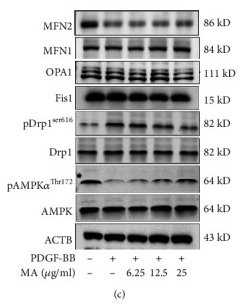Phospho-Calcipressin 1 (Ser163) Antibody - #AF8268
| Product: | Phospho-Calcipressin 1 (Ser163) Antibody |
| Catalog: | AF8268 |
| Description: | Rabbit polyclonal antibody to Phospho-Calcipressin 1 (Ser163) |
| Application: | WB IHC |
| Cited expt.: | WB |
| Reactivity: | Human, Mouse, Rat |
| Prediction: | Pig, Bovine, Horse, Sheep, Rabbit, Dog, Chicken, Xenopus |
| Mol.Wt.: | 22 KD; 28kD(Calculated). |
| Uniprot: | P53805 |
| RRID: | AB_2840330 |
Related Downloads
Protocols
Product Info
*The optimal dilutions should be determined by the end user.
*Tips:
WB: For western blot detection of denatured protein samples. IHC: For immunohistochemical detection of paraffin sections (IHC-p) or frozen sections (IHC-f) of tissue samples. IF/ICC: For immunofluorescence detection of cell samples. ELISA(peptide): For ELISA detection of antigenic peptide.
Cite Format: Affinity Biosciences Cat# AF8268, RRID:AB_2840330.
Fold/Unfold
Adapt 78; Adapt78; Calcipressin 1; Calcipressin-1; Calcium and oxidant inducible mRNA; CSP 1; CSP1; Down syndrome candidate region 1; Down syndrome critical region gene 1; Down syndrome critical region protein 1; DSC 1; DSC1; DSCR 1; DSCR1; MCIP 1; MCIP1; Modulatory calcineurin interacting protein 1; Myocyte enriched calcineurin interacting protein 1; Myocyte-enriched calcineurin-interacting protein 1; Near DSCR proline rich protein; RCAN1; RCAN1_HUMAN; RCN 1; RCN1; Regulator of calcineurin 1;
Immunogens
A synthesized peptide derived from human Calcipressin 1 around the phosphorylation site of Ser163.
Highly expressed heart, brain and skeletal muscle. Also expressed in all other tissues.
- P53805 RCAN1_HUMAN:
- Protein BLAST With
- NCBI/
- ExPASy/
- Uniprot
MEDGVAGPQLGAAAEAAEAAEARARPGVTLRPFAPLSGAAEADEGGGDWSFIDCEMEEVDLQDLPSATIACHLDPRVFVDGLCRAKFESLFRTYDKDITFQYFKSFKRVRINFSNPFSAADARLQLHKTEFLGKEMKLYFAQTLHIGSSHLAPPNPDKQFLISPPASPPVGWKQVEDATPVINYDLLYAISKLGPGEKYELHAATDTTPSVVVHVCESDQEKEEEEEMERMRRPKPKIIQTRRPEYTPIHLS
Predictions
Score>80(red) has high confidence and is suggested to be used for WB detection. *The prediction model is mainly based on the alignment of immunogen sequences, the results are for reference only, not as the basis of quality assurance.
High(score>80) Medium(80>score>50) Low(score<50) No confidence
Research Backgrounds
Inhibits calcineurin-dependent transcriptional responses by binding to the catalytic domain of calcineurin A. Could play a role during central nervous system development (By similarity).
Phosphorylation increases its ability to inhibit calcineurin and decreases protein half-life.
Highly expressed heart, brain and skeletal muscle. Also expressed in all other tissues.
Belongs to the RCAN family.
Research Fields
· Organismal Systems > Endocrine system > Thyroid hormone signaling pathway. (View pathway)
· Organismal Systems > Endocrine system > Oxytocin signaling pathway.
References
Application: WB Species: Mouse Sample:
Restrictive clause
Affinity Biosciences tests all products strictly. Citations are provided as a resource for additional applications that have not been validated by Affinity Biosciences. Please choose the appropriate format for each application and consult Materials and Methods sections for additional details about the use of any product in these publications.
For Research Use Only.
Not for use in diagnostic or therapeutic procedures. Not for resale. Not for distribution without written consent. Affinity Biosciences will not be held responsible for patent infringement or other violations that may occur with the use of our products. Affinity Biosciences, Affinity Biosciences Logo and all other trademarks are the property of Affinity Biosciences LTD.


